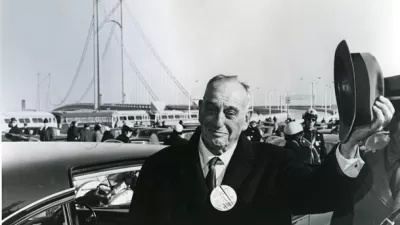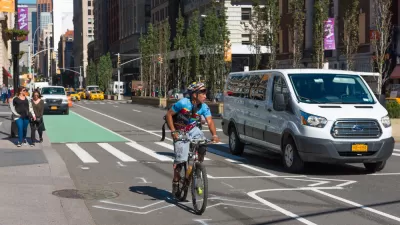Anthony Flint examines the commonalities—and disparities—in the historic legacies of Frederick Law Olmsted and Robert Moses.
For two of the most prominent figures in the history of American planning, the legacies of Frederick Law Olmsted and Robert Moses could not be much more different, yet the two had much in common. According to an article by Anthony Flint: "They both were top-down, hard-charging master planners, creatures of authorities and commissions that helped them get things done. Both perturbed by the jarring cacophony of the city, they sought the best for the American people, and produced glorious public recreation facilities known the world over. They both had a fondness for poetry, and both were accepted at Yale."
Flint's argument, however, is that Moses's strengths were traits he shared with Olmsted: "Olmsted built beautiful parkways, too, and undeniably looked at public works and city-building at a grand scale. His firm’s blueprints were wonderfully regional. He thought comprehensively, encompassing public health benefits, sanitation, circulation, and increases in property values. And he was every bit as dogged, in his own way, as Moses, willing to get his hands dirty, immersing in necessary politics, and practicing wait-them-out patience with great skill. As I’ve said myself about Moses, those are qualities we need today—a regional vision, the skill to align bureaucracies—as coastal cities attempt to build resilience and prepare for the inevitable impacts of climate change."
Moreover, although it's still common to vilify Moses as a symbol of top-down planning, to completely disregard his skill and accomplishments is still likely dangerous: "The warning is clear: the rest of the world shouldn’t fall into the same old trap and practice the top-down planning that Jacobs rebelled against a half-century ago. But it would be a shame if Moses’s excesses have permanently given large-scale planning a bad name, even as conditions on the ground warrant a more regional vision."
FULL STORY: Olmsted the Hero, Moses the Villain

Planetizen Federal Action Tracker
A weekly monitor of how Trump’s orders and actions are impacting planners and planning in America.

Chicago’s Ghost Rails
Just beneath the surface of the modern city lie the remnants of its expansive early 20th-century streetcar system.

San Antonio and Austin are Fusing Into one Massive Megaregion
The region spanning the two central Texas cities is growing fast, posing challenges for local infrastructure and water supplies.

Since Zion's Shuttles Went Electric “The Smog is Gone”
Visitors to Zion National Park can enjoy the canyon via the nation’s first fully electric park shuttle system.

Trump Distributing DOT Safety Funds at 1/10 Rate of Biden
Funds for Safe Streets and other transportation safety and equity programs are being held up by administrative reviews and conflicts with the Trump administration’s priorities.

German Cities Subsidize Taxis for Women Amid Wave of Violence
Free or low-cost taxi rides can help women navigate cities more safely, but critics say the programs don't address the root causes of violence against women.
Urban Design for Planners 1: Software Tools
This six-course series explores essential urban design concepts using open source software and equips planners with the tools they need to participate fully in the urban design process.
Planning for Universal Design
Learn the tools for implementing Universal Design in planning regulations.
planning NEXT
Appalachian Highlands Housing Partners
Mpact (founded as Rail~Volution)
City of Camden Redevelopment Agency
City of Astoria
City of Portland
City of Laramie





























